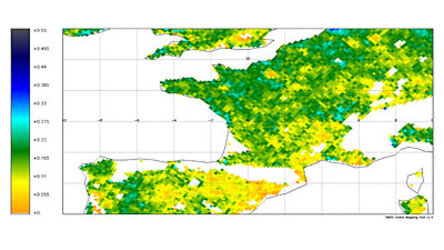SMOS maps Europe’s dry autumn soils
Dry soil resulting from Europe’s exceptionally warm and dry autumn is being monitored by ESA’s SMOS water mission. The images here show the stark comparison between soil moisture in November 2010 and November 2011.
Like the most of the year, this autumn has been particularly dry. In the Netherlands, for example, just 9 mm of rain fell in November, compared to the average of 82 mm. According to the Royal Netherlands Meteorological Institute KNMI, November was the driest since records began in 1906.
Prolonged dry weather in Germany is not only disrupting shipping in the Rhine and Elbe rivers, but has also recently sparked a forest fire in Bavaria.
The UK Environment Agency says that even if England experiences average rainfall over winter and spring, parts of the country are unlikely to see a full recovery from drought conditions in 2012.

The lack of rain across Europe is reflected in the readings from ESA’s Soil Moisture and Ocean Salinity (SMOS) mission.
Orbiting above, SMOS records the amount of moisture held in the surface layer of soil.
With its novel instrument and imaging technique, SMOS can measure the moisture in soil within an accuracy of 4% – about the same as detecting a teaspoonful of water mixed into a handful of dry soil.
Data from SMOS show the difference in soil moisture between this November and November 2010 right across Europe. The difference is especially pronounced in Germany, Austria and further east.
While these maps offer an interesting snapshot, the information is important for a better understanding of the water cycle and, in particular, the exchange processes between Earth’s surface and the atmosphere.
Soil moisture is a variable in the weather and climate system and these data are used by hydrologists, soil scientists, meteorologists and ecologists.
In addition, since the amount of water in soil dictates plant growth and crop yield, the information is useful for agricultural applications and managing water resources.












